BMH Klagenfurt Austria - 31st British General Hospital
Photographs, memories and information about the 31st BGH that was at Jaeger Barracks in Lendorf just outside Klagenfurt in Austria

After the Second World War there was a British Military Hospital at Lendorf within the Jaeger Barracks in Austria. This was the 31st British General Hospital. It was handed over in 1955 as part of the Austrian Peace treaty.
These photos have been kindly provided by John Leggett who was there as a child.

Follow us on Facebook, Instagram and Twitter.

My PTSD assistance dog, Lynne, and I have written a book about how she helps me with my military Post Traumatic Stress Disorder, anxiety, and depression. I talk about my time in the QAs and the coping strategies I now use to be in my best health.
Along the way, I have had help from various military charities, such as Help for Heroes and The Not Forgotten Association and royalties from this book will go to them and other charities like Bravehound, who paired me with my four-legged best friend.
I talk openly about the death of my son by suicide and the help I got from psychotherapy and counselling and grief charities like The Compassionate Friends.
The author, Damien Lewis, said of Lynne:
"A powerful account of what one dog means to one man on his road to recovery. Both heart-warming and life-affirming. Bravo Chris and Lynne. Bravo Bravehound."
Download.
Buy the Paperback.

This beautiful QARANC Poppy Pin Badge is available from the Royal British Legion Poppy Shop.
For those searching military records, for information on a former nurse of the QAIMNS, QARANC, Royal Red Cross, VAD and other nursing organisations or other military Corps and Regiments, please try Genes Reunited where you can search for ancestors from military records, census, birth, marriages and death certificates as well as over 673 million family trees. At GenesReunited it is free to build your family tree online and is one of the quickest and easiest ways to discover your family history and accessing army service records.
More Information.
Another genealogy website which gives you access to military records and allows you to build a family tree is Find My Past which has a free trial.
John recalls:
I lived in quarters there as an army "brat" in 1954/55 shortly before the occupation forces left Austria. I'm not sure if it was a fully fledged BMH but it may have been designated 31 (British) General Hospital and was in Jaeger Barracks, Lendorf just outside Klagenfurt. I believe the barracks still stands today. The site is still there and viewable on Google Earth or Maps. The one with the old field ambulance was taken somewhere between Klagenfurt and Vienna and is my mother, sisters and I returning from collecting Mum from Klagenfurt around 1953 or 1954.

Captain King, Theatre Sister and James Just, Operating Theatre Technician:

Operating Theatre Technicians:

British Zone Austria Loiblpass Frontier Control Post:

Fun at the swimming pool with Colonel Watts going in the brink:

Sports day 1954:

Former Royal Air Force Regiment Gunner Jason Harper witnesses a foreign jet fly over his Aberdeenshire home. It is spilling a strange yellow smoke. Minutes later, his wife, Pippa, telephones him, shouting that she needs him. They then get cut off. He sets straight out, unprepared for the nightmare that unfolds during his journey. Everyone seems to want to kill him.
Along the way, he pairs up with fellow survivor Imogen. But she enjoys killing the living dead far too much. Will she kill Jason in her blood thirst? Or will she hinder his journey through this zombie filled dystopian landscape to find his pregnant wife?
The Fence is the first in this series of post-apocalyptic military survival thrillers from the torturous mind of former British army nurse, now horror and science fiction novel writer, C.G. Buswell.
Download Now.
Buy the Paperback.
If you would like to contribute to this page, suggest changes or inclusions to this website or would like to send me a photograph then please e-mail me.


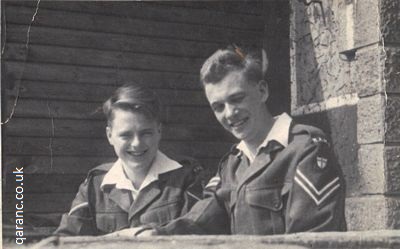

The RAMC Football team in 1954.

RAMC staff skiing.
A Google map of the buildings which are used by the Austrian Army:
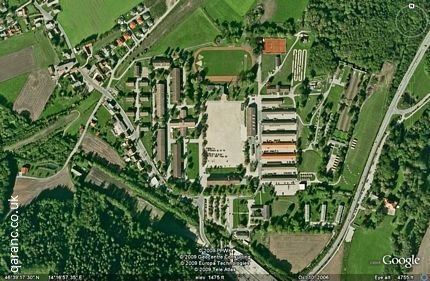
***********************************************
The following photos are from the collection of Lewis Grenville Little, also known as Taff (being a Welshman), and were kindly donated by his son, David. Lewis served with the Royal Army Medical Corps at 31 British Military Hospital in Austria during the 1950s. He did not undertake military service during WW2 as he was a Bevin Boy, a coal miner. When released, he joined the RAMC and his first overseas posting was Austria, living in Klagenfurt with his wife and children.
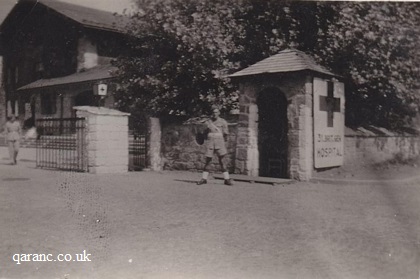
Sentry Guard Main Gate 31 British General Hospital Klangenfurt

David's dad as a LCpl RAMC standing next to 1950s Humber 4x4 car
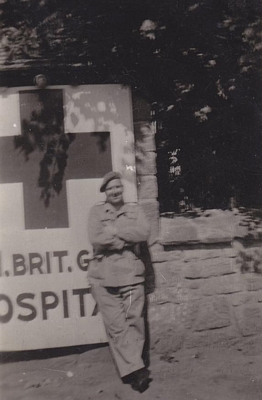

Note the front army ambulance. Look closely and one will see a figure at rest on the right. Look this time to the rear left and there is a rather small figure there. That is Lewis's son, David.

Lewis, second left and another soldier, with a group of Austrians who worked as drivers at the hospital. Some were former Prisoners of War and were paroled initially to work as drivers and many stayed on to secure an income.
Lewis rose to the rank of Staff Sergeant and served a full 22-year term and served in Austria, Cyprus during the Eoka emergency, Benghazi Libya and numerous locations in the UK. He finished his military service as the Chief Clerk at the Military Hospital Tidworth Garrison.
***********************************************

How I came to the Klagenfurt lab is a tale that may be worth telling. At school (Parmiter's Grammar School, Bethnal Green, East London) I had an undistinguished record but developed an ambition to study Zoology. This led me to focus on biology homework and to do this task in the local Public Reference Library. It also led me to leave school in 1950 after one year in the sixth form so as to continue on a workable path to university studies by doing the part-time evening Intermediate BSc course at Birkbeck College, working as a laboratory technician by day. There was no deferment of National Service for part-time study so I was due for call-up in 1951.
In the reference library I happened to find a glossy pamphlet published by the Royal Army Medical Corps describing its work and establishments and, at just the right moment, was able to identify my preferred posting when my time would come: the lowest grade of lab tech because that's all that was open to NS men, at BMH Klagenfurt. Alternatives would have included the Far East, etc.
At my Medical/enrollment (at Wanstead, I seem to remember, about April) there was a form to complete in which there were two questions about role: 1. Can you cook? and 2. Do you have any preferred Army posting? I denied cookery skills and, without much hope, gave all the details I could of the rank, grade, and posting I hoped for. Amazingly, come the end of basic training in December, my posting was exactly what I had asked for, whereas most of my draft were sent to the Far East and many ended up in the Korean War. Although I hated the regimentals (but enjoyed parade drill) my army service was a very positive experience with the opportunity to take responsibility for real functions in the lab and on the wards, ones that made a difference to the treatment of the patients.

The Path lab staff of 1953 from left to right are Bernie Cohen, Alec Fearn, Major Stuart, Captain Beeson, Eric Barr, Malcolm Wright and Bert Cheshire. Bernie says:
I kept up with Brian Beeson after our Nat Service, both during my student days in London and years later when married and with a young family our holidays would take us from Scotland to France, sometimes staying a night or two with his family at Caton, nr Lancaster. Beeson served as Home Office Pathologist for a swathe of the country including Preston, Lancaster, dealing with murders etc. Sadly, he developed a heart murmur, but given his ebullient nature did not allow this to stop his hectic lifestyle, leading to an early death. I suppose that today he would be fitted with a device to restart the heart and might go on until old age.
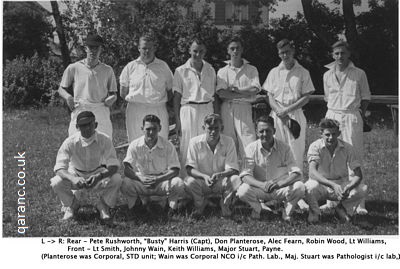
From left to right rear: Pete Rushworth, "Bust" Harris (Capt), Don Planterose. Alec Fearn, Robin Wood, Lt Williams.
Front Row: Lt Smith, Johnny Wain, Keith Williams, Major Stuart, Payne.
(Planterose was Corporal, STD Unit; Wain was Corporal NCO i/c Path Lab; Maj Stuart was Pathologist i/c Lab.)
Fearn also appears in the cricket team photo. I believe that he either attended coaching with or even tried out for Surrey at the Oval. I don't know where he worked as a lab tech and likewise know nothing about the others shown.
My understanding about the origin of the barracks was that it had originally belonged to the SS, there being no separate Austrian army as far as I know.

RAMC Corps Day Parade
Planterose was the STO in my time. That role was one of the few that enabled NS men to be given a stripe so as to boss their patients about! I kept up with him for quite a long time. He took a PhD in virology and spent some years at an American research lab, then was at (probably) the Animal Viruses lab, Pirbright, where he was associated with Fred Brown a prominent virologist noted for studies of Foot & Mouth etc. Planterose died early -- a fate that has affected several virologists of my acquaintance.
Wain was an NCO because he had signed on for the minimum time rather than just do National Service. He was an effective manager in the lab.

The camp gate: The board on the left shows that it was also the local RMP HQ.

Remembrance Day parade 1952. Ambassador (Sir H. Caccia, CinC M-G Urquhart)

Another image of the swimming pool shows some young women were involved. Presumably they were some of our QARANCs.
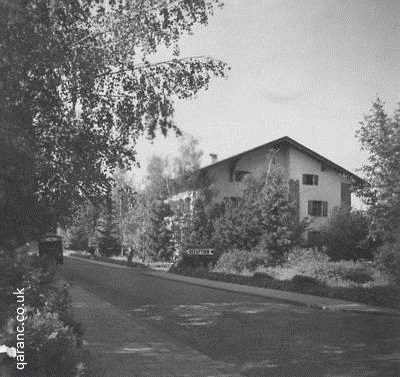
Reception: The path lab occupied two floors (Ground & Basement) at the end of the barrack block behind the notice.
I had this published in The Lancet:
SIR,-A paper on flies and diarrhoeal disease in your issue of April 27 (p 993) called to mind an embarrassing episode of my youth. While on national service at the British Military Hospital, Klagenfurt, Austria, I found myself in 1951 to 1953 learning hospital laboratory practice "on the job". The high point of my summer spell of duty as routine bacteriologist was the isolation in pure culture and identification of Salmonella typhi. So impressed was I by this achievement that I kept the petri dish inverted on the bench to show to visitors. We had no refrigerator. At the next Commanding Officer's inspection, I presented this plate for scrutiny. Fortunately the Colonel was no bacteriologist, or he would have noticed the trail of microcolonies that, in neatly staggered rows of three, meandered across the plate, terminating at a chip in its side-wall. Clearly an insect, probably a housefly, had entered, feasted on the bacteria, and departed, its feet and proboscis well-laden. Fingers were crossed and tenterhooks deployed, but the dreaded outbreak of typhoid never materialised. Nor was I promoted beyond Private! Royal Army Medical Corps.
Bernie Cohen
***********************************************
My first posting was to BMH Klagenfurt in Austria, a truly idyllic site on the outskirts of the town. This hospital had been built for the Austrian Army and was apparently finished just before it was captured by the British 8th Army after it had worked its way through Italy. As the only STO (Special Treatment Orderly) clinic/office was in the Laboratory block, and my Medical Officer was also the pathologist Captain Kellerer, I also worked as an extra pair of hands in the Path lab.
All the blocks included the QARANC mess, officers mess and married families quarters were all situated within the large grounds and were luxurious compared with what I had come from at Netley. When I left in July 1955 after the Austrian Peace treaty was signed in the spring/summer of 1955 I was posted to BMH Hamburg, but due to the withdrawal of many troops from that area of BAOR, the decision was taken to close the clinic when I had been there only a month and transfer the workload and me to BMH Hannover where I spent the next 12 months.
I also noted on Google maps that the buildings are still all there in the Lendorf district of the town as well as the buildings which were the RASC depot next door, even down to the married quarter houses. The only thing missing which was there was the open air swimming pool. I said previously that facilities were above average. It was better than a holiday camp and the weather in the spring and summer of 1955 was extremely warm so I spent many happy hours after work in and around the pool. Dennis Read
***********************************************
So pleased to find the building/hospital I was born in 1946. After a highly decorated war effort my Father had been posted to Klagenfurt and my mother went to join him as she was expecting me (her first child). My original birth certificate is of course a Military one, and I have been told the Hospital was indeed an SS one, the Maternity unit used in particular for the birth of Lebensborn babies (Hitlers master race plan). The town had many orphanages run by nuns for the results! I was christened in the Cathedral, before being brought back to England in my carry-cot. The rest of my early life was to be spent traipsing round the world, mainly in the Colonies of Africa. Sheila
If you would like to contribute any info, photographs or share your memories then please contact me.
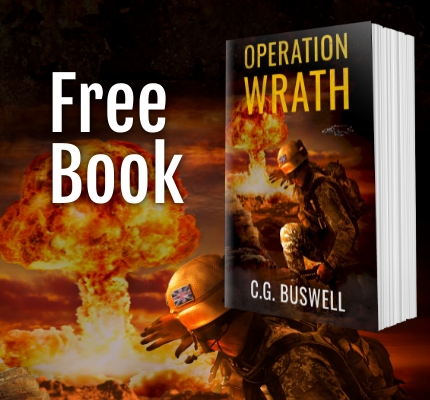
Free Book.
The death of the Brotherhood will be avenged.
RAF gunner Jason Harper and a team of Special Air Service operators are enraged after the death of their brothers by a terrorist drone strike. They fly into south-eastern Yemen on a Black-op mission to gather intelligence and avenge the death of their comrades.
Can they infiltrate the Al-Queda insurgents' camp, stay undetected, and call down their own drone missile strike and get home safely?
Will they all survive to fight another day?
Operation Wrath is a free, fast-paced adventure prequel to the non-stop action The Fence series by military veteran author C.G. Buswell.
Download for free on any device and read today.
This website is not affiliated or endorsed by The Queen Alexandra's Royal Army Nursing Corps (QARANC) or the Ministry of Defence.

